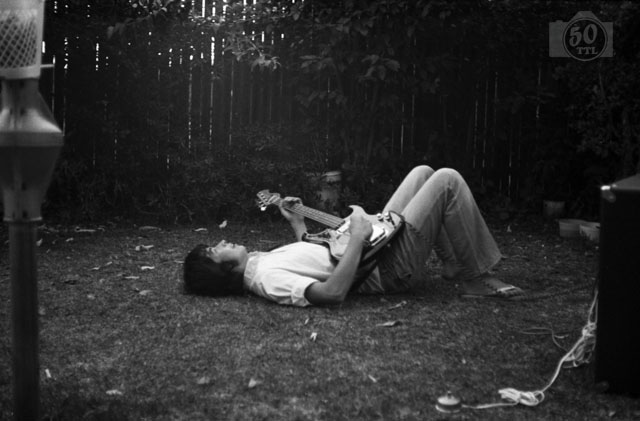
These days they’re called garage bands; back then, these fellas didn’t even have a garage to practise in, they just set up in the back yard. This is a school friend continuing his Saturday afternoon band rehearsal while chilling out on his back under the Hills hoist in a Manning back yard.
I mention the Hills hoist because it adds some interesting context to the image. The full frame of the photo includes the Hills hoist with its peg basket. Back in 1972, I cropped it as above, taking out the Hills hoist. My intention then was to focus attention on my friend. The full frame is below, allowing the Hills hoist and the picket fence to show the suburban back yard dimension of the image.

In 1972, I shot, processed and printed at least 29 rolls of black and white film, mostly 20 to 24 shots to a roll. That tells me that I was now loading my own film into cartridges. It was much cheaper to buy in bulk and load your own. I learnt to undertake fiddly tasks in total darkness, using touch, spatial awareness and precision to compensate for lack of vision.
The fact that it was cheaper to shoot black and white film doesn’t mean it was easy. I had no darkroom, so every time I wanted to print some photos, I had to take over the laundry in the family home some time after dark. I would set up a safe light, tape black plastic over the windows, put the enlarger on the washing machine and place the processing trays on the ironing board. The final print wash was in the laundry trough.
I mixed chemicals, adjusted temperatures and meticulously timed processes to produce consistent results. Eventually, I even developed a very reliable temperature-sensing finger. Seriously! I could mix hot and cold fluids and simply swish my right index finger through the solution and pick when it was at 20 degrees Celsius. I always checked it with a thermometer, but the result was always between 19.5 and 20.5 degrees. What a useless party trick that turned out to be!

Here is a photo looking down from the Gloucester Tree in Pemberton, Western Australia. Similar photos have been taken time and time again from this fire lookout atop a karri tree. It’s just a natural pic to take once you climb the 153 spikes that spiral up the tree trunk to take you to the cabin perched 72m above the ground.
So it’s not an original photo and there may be many like it, but when I used to show this slide to people, their reaction was often one of respect that I had climbed the tree, especially those who thought they would never be able to do the same. Then you realise that people who cannot bring themselves to climb the tree are never going to take that photo. They are only going to see that vertiginous view through someone else’s photo.
Clearly then, one way to take photos that no one else takes is to go to places that no one else goes. Then you can show people new angles on familiar things, and sometimes you can show them things that no one else has ever seen before.
That’s what makes photographers lie in the dirt to get a different photo, or climb a ladder to get a higher viewpoint. It makes them get up early in the morning to catch the dawn light at a particular angle. It’s also what makes them venture into danger in war zones or within the attack zone of a wild animal.
I have never been drawn to go so far as to risk death or serious injury for a photo. Maybe I would have taken better photos if I had. Maybe 50TTL would have been a mere 8TTL if I had taken more risks at age 20.
brad barber
20 May 2018really enjoying this Steve. looking forward to following it over the course. cheers